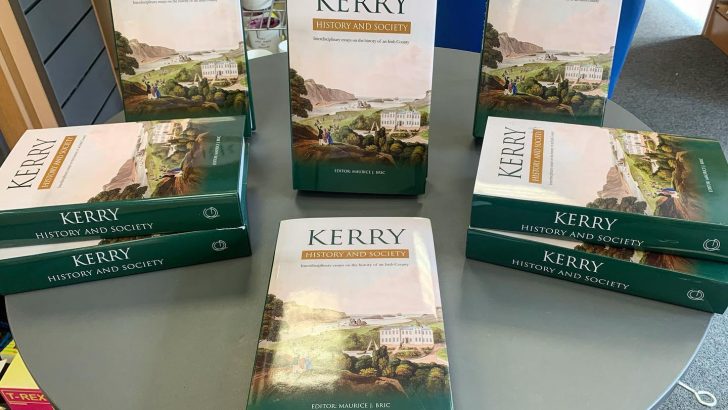Kerry: History & Society
edited by Maurice J. Bric, introduction by Joe Lee, epilogue by Tommy O’Connor (Geography Publications, €60.00)
This tremendous volume is the latest in the well established series of County Histories which the publishers have been producing for at least two decades. They are a sort of Irish version of the British ‘Victoria County Histories’; though unlike that British series it will see completion.
Here then is a collection of insightful essays on the history of Co. Kerry. Topics discussed range from pre-history to ‘Party organisations, political engagements and electioneering in Kerry, 1927-1966’.
The book contains some surprises. Despite the popular belief that the Celts were the early inhabitants of the country, from his extensive research Archaeologist William O’Brien claims that the Iron Age group on the continent, known as the Keltoi never came to Ireland.
A number of the essays concentrate on the land of Kerry and its use. There is an account of how land tenure in medieval Kerry was shaped by successive approaches to agriculture.
A chapter on the Manor of Castle Island describes how the Anglo-Normans administered the county and the manner in which they divided the land. John Knightly traces the evolution of the demesne at Kilcoleman Abbey at Milltown from 1730 to 1830.
***
Toby Barnard describes coal-mining, copper-mining and linen manufacture enterprises in the county in the 18th-Century, all of them ending in failure.
In a thoroughly researched essay Kieran Foley endorses the claim in 1852 of the Killarney Poor Law Guardians that they had “given adequate famine relief to the poor and had protected the pockets of the ratepayers”.
One of the most val-uable essays is on the assisted emigration from the Lansdowne estate at Kenmare during the Great Famine and the glimpse it provides on the new life those emigrants carved out for themselves and their children in America.
There are some interesting essays on religion. Elva Johnston lists the saints associated with Kerry. Outstanding among them was St Brendan. Known both as Brendan the Navigator, or Brendan of Clonfert, he founded a monastery at Ardfert in Kerry and at Clonfert in Galway.
His status as a celebrity was sealed with the appearance of Navigatio Sancti Brendani abbatis at the end of the 8th-Century. Seemingly, he sailed to places in northern Europe. It is even possible that he touched ground in the Faroe Islands and Iceland.
This fine study of Co. Kerry has no fewer than 29 essays”
However, notwith-standing Tim Severin’s heroics and remarkable voyage across the North Atlantic, there is no archaeological evidence that he made landfall in North America, though it can be argued on the basis of the evidence in the Navigatio that the author or authors of that text were familiar in detail with the north-western Atlantic Ocean, and its volcanoes, sea fogs, huge marine animals and the icebergs that descend the Davis Straits to the coast of Newfoundland.
In his essay Maurice Bric celebrates the achievements of the Liberator especially his successful leadership of the campaign for Catholic Emancipation. Oliver Rafferty leaves one in no doubt about the national and international stature of Bishop David Moriarty.
A somewhat dysfunctional relationship has existed between Ireland and her sister island over the centuries.
This is the sub-text in Donnacha Seán Lucey’s ‘Nationalism and the land question in Kerry 1872-92’. The dysfunctional relationship was never more toxic than in the period from 1916 to 1922.
The atmosphere of that period is captured in Gavin Foster’s account of the War of Independence and the Civil War in Kerry. He records the significant incidents in the struggle between the crown forces and those of Sinn Féin. Curiously, he overlooks the most crucial event, namely the police mutiny in Listowel. This led to widespread resignations from the Royal Irish Constabulary, their replacement by the Black and Tans and, as a result of their brutality and misconduct, the crown forces losing the support of the majority of the Irish people and thus not being able to pacify the nation.
This fine study of Co. Kerry has no fewer than 29 essays, each comprehensive with regard to their content and exuding profound scholarship.
It would be churlish to conclude without saluting Maurice Bric and Willie Nolan. Maurice has exhibited every editorial skill in seeing this magnificent thesaurus of information on Kerry through the printing presses.
The founder of Geography Publications, Willie from 1985 onwards has been supervising the publication of these county histories, of which this is the 28th volume. In so doing he has won for himself a unique place in the ranks of Irish historiographers.


 Photo: O'Mahony's Booksellers Tralee
Photo: O'Mahony's Booksellers Tralee 